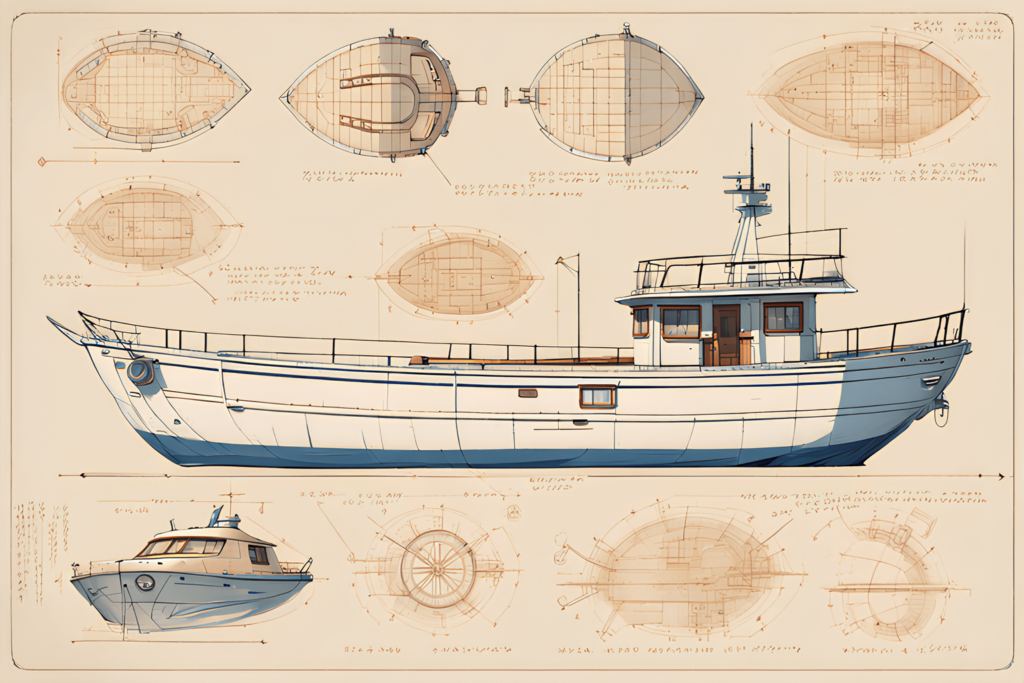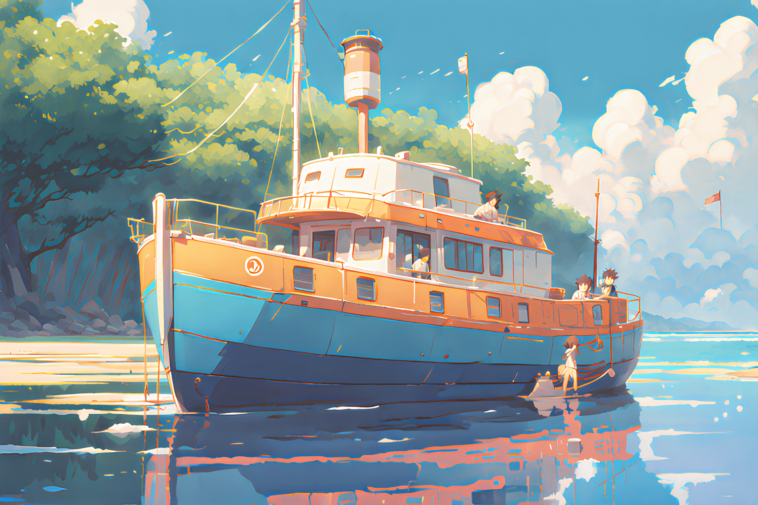Are you ready to turn your weekend into a thrilling sea adventure? What if making your dream boat was simpler than you thought?
DIY Novelty Boat Plans & Blueprints open a door for watercraft lovers to create unique boats. With 21 new designs, these PDF plans fit all skill levels and dreams.
Our package has 12 paddle wheel boat designs and 9 unique novelty boats. You’ll find plans for Bicycle Pedal Boats and Foot Pedal Catamarans, plus Battle Surfboards and Cold Lightning. Each plan comes with clear steps to build your watercraft.
Whether you’re new or skilled, these plans will spark your next water project. Enjoy the thrill of making something special on the water.
Key Takeaways
- 21 diverse boat plans available for immediate download
- Includes 12 paddle wheel and 9 novelty boat designs
- Suitable for multiple skill levels
- PDF format for easy access and printing
- Comprehensive instructions for successful boat building

Why Choose DIY Novelty Boat Plans?
Exploring DIY boatbuilding kits is a creative journey for water lovers. It makes building boats fun and achievable for everyone, from beginners to experts.
Creating your own boat is more than saving money. It’s about growing your skills and showing off your style.
Unleashing Your Creativity
Building your boat lets you make it your own. You can design a vessel that shows off your personality and meets your needs. DIY kits help you create unique boats.
- Personalize boat color and style
- Adapt design to specific water activities
- Create one-of-a-kind watercraft
Cost-Effective Solutions
DIY boat plans save you money compared to buying a pre-made boat. Here are some price comparisons:
| Boat Plan Type | Price |
|---|---|
| Hydroplane Race Boat | $50 |
| Catamaran Race Boat | $75 |
| Outboard Runabout | $30 |
| Inboard Runabout | $100 |
Building Skills and Knowledge
Every boat you build is a chance to learn. DIY kits help you improve your woodworking, engineering, and problem-solving. You’ll get better with each project, learning about boat design and making.
“The joy is in the journey of creation, not just the final product.” – Master Boat Builder
DIY boat plans teach you about choosing materials and mastering construction. It’s a journey that goes beyond just building a boat.
Different Types of Novelty Boats
Exploring small craft construction plans opens a world of creativity for boat lovers. Handmade boat blueprints let DIY makers create unique watercraft. These designs are different from traditional ones.
Novelty boats mix imagination with maritime engineering. They go beyond usual boat-building. They challenge old design ideas and inspire makers to be creative.
Classic Designs
Traditional boat designs are great for DIY boat builders. These classic blueprints include:
- Wooden paddle boats with vintage charm
- Simple rowboats with clean, functional lines
- Traditional sailboats with timeless appeal
Modern Innovations
Contemporary small craft construction plans are bold. They include:
- Motorized surfboards
- Compact personal watercraft
- Hybrid propulsion systems
Themed Boats for Fun
Handmade boat blueprints now include fun and creative ideas. They turn water transportation into art:
| Boat Theme | Unique Features |
|---|---|
| Battle Surfboards | Aggressive design for competitive water sports |
| Floating Swimming Platform | Family-friendly design with multiple activity zones |
| Pontoon Party Boat | Spacious deck for sun-bathing and entertainment |
“The beauty of DIY boat building lies in transforming imagination into floating reality.” – Nautical Crafting Magazine
Every unique design is a chance to show personal creativity. It’s also a challenge to build your own watercraft. Whether you’re experienced or new, novelty boats have something special for everyone.
Essential Tools and Materials
Starting a DIY boat building project needs careful planning and the right tools. Whether you’re using boat building guides or DIY kits, knowing the essential tools is key to success.
Building a boat is a thrilling adventure that requires precision and creativity. The quality of your tools greatly affects your boat’s final look.
Common Tools You’ll Need
- Measuring tools: Tape measure, ruler, square, and marking knife
- Cutting tools: Hand saws, power saws, chisels, and planes
- Joining tools: Clamps, screws, nails, and adhesives
- Finishing tools: Sanders, files, brushes, and rollers
Choosing Quality Materials
Choosing the right materials is critical in boat building. Durability and water resistance are top priorities. Here are some recommended materials:
- Marine-grade plywood
- Fiberglass
- Epoxy resin
- Waterproof adhesives
Safety Gear for DIY Projects
“Safety first is safety always” – Charles M. Hayes
Keeping yourself safe during boat building is essential. You’ll need:
- Safety glasses
- Dust masks
- Protective gloves
- Hearing protection
DIY boatbuilding kits usually include safety gear recommendations. Always follow the manufacturer’s guidelines and take precautions for a safe and fun building experience.
Step-by-Step Guide to Building a Novelty Boat
Starting a boat building project needs careful planning and execution. Guides for boat building offer a detailed approach to making small watercraft. This helps both new and experienced builders create unique boats.
Building your own boat involves several key stages. Each step requires focus on details and a systematic approach. The journey from idea to finished boat takes patience, skill, and planning.
Planning Your Project
Good boat construction begins with careful planning. Think about these important points:
- Determine the boat’s size and purpose
- Choose a design from boat building guides
- Check your skill level and workspace
- Set a realistic timeline for finishing
Gathering Materials
Choosing the right materials is key for small boat plans. Good materials mean your boat will last and perform well.
| Material | Purpose | Recommended Type |
|---|---|---|
| Wood | Hull construction | Marine-grade plywood |
| Epoxy | Sealing and bonding | Waterproof marine epoxy |
| Fiberglass | Reinforcement | Lightweight cloth |
Assembly Instructions
Accurate assembly is vital for your boat’s strength. Follow these important steps:
- Prepare a workspace with good air flow
- Cut materials as the guides suggest
- Build the frame with exact measurements
- Apply protective coatings
- Do a thorough quality check
Remember, patience and precision are your best tools in boat construction.
Tips for Customizing Your Boat Design
Turning a basic boat plan into a unique masterpiece needs creativity and planning. Custom boat drafting services let builders show off their style and vision. Whether you’re experienced or new, making your boat special can make the project unforgettable.
Creating handmade boat blueprints gives you lots of design freedom. Here are some fun ways to make your boat stand out:
Adding Unique Features
- Install custom storage compartments
- Create specialized seating arrangements
- Design integrated navigation systems
- Incorporate personal safety enhancements
Painting and Finishing Touches
The right paint and finish can change your boat’s look and protect it. Here are some expert tips:
- Choose marine-grade paints resistant to water and UV damage
- Experiment with color schemes that reflect your personality
- Use high-quality sealants for long-lasting protection
Personalizing Your Boat’s Theme
Custom boat drafting services open up endless design options. From nautical themes to abstract artistic expressions, your boat can show off your creative side.
“A boat is freedom, beauty, and endless possibility waiting to be discovered.” – Unknown Boat Builder
With careful planning and creative thinking, your handmade boat blueprints can become a truly remarkable watercraft that stands out from standard designs.
Unlock the secrets to building your dream boat with MyBoatPlans! With detailed plans for over 518 boats and expert video tutorials, you’ll have everything you need to create your perfect vessel. Click here to begin your journey!
Maintenance Tips for Your DIY Boat
Keeping your homemade watercraft in top shape needs regular care. Proper upkeep not only makes your DIY boat last longer but also keeps your water trips safe and fun.
There are several important steps to keep your handcrafted boat in great shape. These steps help protect your investment and keep your boat running well.
Regular Cleaning and Care
Regular upkeep is key for DIY Novelty Boat Plans & Blueprints. Make a cleaning schedule to keep your boat looking new:
- Rinse boat thoroughly after each use
- Use marine-grade cleaning solutions
- Inspect for any surface damage
- Dry completely to prevent moisture buildup
Identifying Wear and Tear
Spotting problems early can save you time and money. Look out for these signs:
Download over 500 Boat Plans. Click on the link below.
-->Click Here<--
- Loose fittings or connections
- Cracks in hull or structural components
- Signs of water intrusion
- Rust or corrosion on metal parts
Seasonal Storage Tips
It’s vital to protect your homemade watercraft during off-seasons.
| Storage Aspect | Recommended Action |
|---|---|
| Winter Storage | Store in dry, covered area |
| Summer Storage | Use breathable boat cover |
| Long-Term Protection | Apply marine-grade sealant |
“A well-maintained boat is a sailor’s best companion.” – Nautical Wisdom
By sticking to these maintenance tips, your DIY boat will stay in great shape for many water adventures.
Resources for DIY Boat Builders
Starting a boat building project needs good resources and guides. Whether you’re new or have experience, the right tools and support are key. They can greatly help your DIY boat project.
Recommended Books and Guides
Getting into boat construction means having good reference books. Here are some top picks:
- Classic wooden boat design books by famous naval architects
- Comprehensive guides on different boat-building methods
- Step-by-step manuals for various boat types
“Knowledge is the most important tool in any boat builder’s workshop.” – Experienced Shipwright
Online Forums and Communities
Online platforms are great for boat building support. They offer:
- Advice from experienced boat builders
- Help with tricky construction problems
- Chances to connect with other boat lovers
Video Tutorials and Workshops
Visual learning has changed boat building guides. Today, you can find:
- YouTube channels focused on boat building
- Virtual workshops with boat designers
- Online courses for all skill levels
With 719 results found on DIY boat building plans and kits, builders have a lot of resources. Experts like Robert Dillon, Michael Storer, and Steve Killing offer design ideas and technical help.
The Environmental Impact of Building DIY Boats
DIY boat plans now focus on being green. Builders aim to reduce harm to the environment. This change is key in making boats.
Sustainable Materials for Boat Building
Using green materials changes boat making. Today, builders have many eco-friendly choices:
- Recycled aluminum with high strength-to-weight ratio
- Responsibly sourced wood from certified forests
- Composite materials with reduced carbon footprint
- Renewable fiberglass alternatives
“Every sustainable choice in boat building contributes to protecting our marine ecosystems.”
Eco-Friendly Practices in Boat Construction
Green methods help lessen harm to the planet. DIY fans can follow these steps:
- Using water-based, low-VOC paints
- Minimizing chemical waste
- Selecting energy-efficient tools
- Implementing proper material recycling
Reducing Waste in Small Craft Construction Plans
Starting with careful planning cuts down waste. Precise measurements and smart material use help a lot. This makes DIY boat projects better for the planet.
Choosing the right materials and building wisely makes DIY boats both new and green.
Inspiring Stories from DIY Boat Builders
The world of DIY boat building is full of amazing stories. People are creating new and exciting boats from scratch. They turn simple plans into incredible vessels that amaze everyone.

Community Projects that Spark Inspiration
Local boat-building groups are places of creativity and teamwork. People with different skills come together. They make unique boats for many reasons:
- Charity boats for local fundraising events
- Educational workshops for aspiring shipwrights
- Community restoration projects
Unique Personal Experiences
Many DIY boat builders have incredible stories to tell. Like the weekend carpenter who made a sailboat from an old plan. The Weekender project shows what’s possible with DIY boat building:
| Boat Specification | Details |
|---|---|
| Sail Area | 120 sq ft |
| Keel Depth | 10 inches |
| Bowsprit Length | 5 feet |
Innovations in Boat Design
“The beauty of DIY boat building lies in transforming imagination into reality.” – Professional Boat Builder
New designs keep coming from the DIY shipwright community. They create everything from sport submarines to green watercraft. These innovators are changing what’s possible with boat plans.
They make lightweight kayaks from Okoume marine plywood and try new designs. They use materials like Spanish cedar and stitch-and-glue construction. This opens up new options for boat lovers.
Frequently Asked Questions about DIY Boat Projects
Starting a DIY boat project can seem scary, but knowing the basics helps. Most people find making a custom boat easier than they thought. DIY kits make it simpler for beginners to get into marine crafting.
The time it takes to build a boat depends on the design and your skill level. Beginners might take 4-6 weeks, while experts can do it in 2-3 weeks. Guides suggest starting with simple designs to learn the basics.
Key skills for boat building include woodworking, measuring accurately, and patience. Woodworking skills are helpful, but many learn from online tutorials and workshops. Kids can join in with adult help, making it a great family activity.
When planning a DIY boat project, think about the cost. Most simple designs cost between $95-$250. Good guides and community resources can save money and improve your skills. Each project makes you better, making future boats easier to build.
FAQ
What are DIY Novelty Boat Plans?
DIY Novelty Boat Plans are blueprints for making unique boats at home. They offer 21 designs, including 12 paddle wheel boats and 9 novelty boats. You can download them instantly in PDF format. These plans are for all skill levels, from beginners to experts.
How difficult is it to build a DIY boat?
Building a DIY boat’s difficulty depends on the design and your skills. Some, like the “Corky” sailer, are easy for beginners. Others need more woodworking skills. Most plans have step-by-step guides, helping both new and experienced builders.
What materials do I need to build a novelty boat?
You’ll need wood, fiberglass, and marine-grade hardware. The materials vary by design. Basic tools like a measuring tape, saw, and drill are also needed. Don’t forget safety gear like eyewear, gloves, and a mask.
How long does it take to build a DIY boat?
Build times vary. For example, the “Thing” boat took about two months. Simple designs might take weeks, while complex ones could take months.
Are these boat plans suitable for children?
Yes, some designs, like the “Corky” sailer, are great for family projects. They’re good for kids with adult supervision. But, always supervise children when using tools and materials.
Can I customize the boat designs?
Absolutely! You can add your own touches, change colors, and adapt designs. For example, the “Marty Paddle” boat has a colorful look and custom paddle wheel.
What maintenance do DIY boats require?
Regular maintenance is key. This includes cleaning, polishing, checking for wear, and proper storage. Using race boat polishing can keep your boat looking and performing well.
Are there environmental considerations for DIY boat building?
Yes, you can use sustainable materials and eco-friendly practices. Some designs, like paddle wheel boats, are environmentally friendly. Reducing waste and proper disposal help make boat building more sustainable.
Where can I get support for my DIY boat project?
There are many resources available. Online forums, boat-building communities, video tutorials, and workshops can help. The plan collection also includes designs from magazines, providing detailed guidance.



